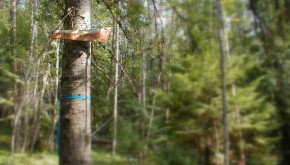
One summer day, in the early nineties, before we started writing a forest management plan, my father and I walked the dogs up an old logging road through our property in the northern Idaho Panhandle. Bryce, my Norwegian elkhound, ran through the thick underbrush and densely spaced trees. My father’s dog Terra, a lab, and the newly acquired husky-collie, Max, both followed. My father and I stayed on the logging road for the simple reason that we couldn’t find a path through the dog-hair thickets.
As we approached the top of the hill and the road’s curve, a feature we like because during winter the toboggan takes the corner at high speeds, a large hawk dive-bombed us.
I remember an enormous wing span and the golden-brown ruffle of feathers—“ruffle” too tame a word for the power of this bird. I ducked, instinctively.
“That was a goshawk,” said Dad.
We remembered that experience when we began writing a management plan for our stewardship forest about eleven years ago. In other words, we wrote the goshawk into our plan. Part of our management objectives includes habitat. Now we know that we should have started our management plan twenty years ago!
Just a few summers ago, after implementing a management plan, after becoming a stewardship forest, my father and I walked the same logging road. We were on our way to what we’ve named Goshawk Corner. We followed the dogs off the logging road and walked through our pre-commercially thinned forest. My mom and I did a lot of that sweat equity work ourselves. We could see spaces now between the trees. We could walk through those spaces. We're far more aware not only of individual trees on the property but also the topography of our land. We aren’t limited to a few trails but can wander. It isn’t simply pastoral, though. We also have a fire break, and there is room for firefighters to maneuver. The goshawk has been back, too. The hawk is part of our stewardship plan, which includes forest management and habitat enhancement.
We began by doing nothing, and we now have more than enough to do. We're perpetually behind. Nevertheless, we were able to make the transition to managing our land by realizing that we had choices to make and that there are foresters and loggers who could help us assess our own particular needs and focus.

